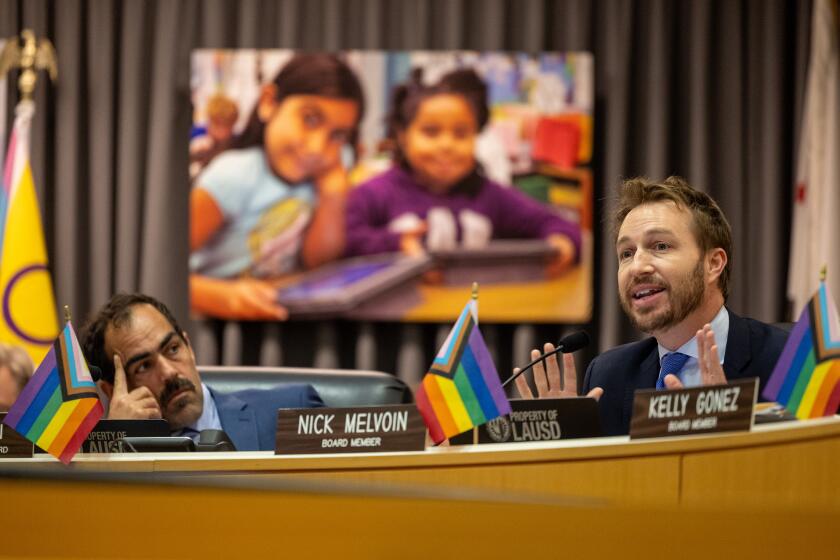California’s new high school requirement: Balance a checkbook, manage credit, avoid scams

California students will have to complete a course in pocketbook economics — balancing a checkbook, managing credit cards, avoiding scams — to graduate from high school under a bill that will become law, state lawmakers announced Thursday.
“We need to help Californians prepare for their financial futures as early as possible,” Gov. Gavin Newsom said in a statement. “Saving for the future, making investments and spending wisely are lifelong skills that young adults need to learn before they start their careers, not after.”
This bill — which has drawn criticism from those concerned about another requirement on crammed academic schedules — orders school districts and charter schools to offer a stand-alone, one-semester course in personal finance. To meet the requirement, the class cannot be combined with any other course beginning in the 2027-28 school year.
Students graduating in 2031 will have to pass the class.
The agreement among state lawmakers avoids a ballot-box verdict by voters. Backers of the new requirement had gathered enough signatures to place the proposal, dubbed the California Personal Finance Initiative, on the November ballot. They will now shut down that effort.
The new requirement and the bill that will make it law “will benefit countless future generations of Californians,” said Tim Ranzetta, a wealthy Silicon Valley businessman who bankrolled the signature gathering for the ballot initiative and also supported the legislation.
Thursday was the legal deadline for Ranzetta to withdraw the ballot initiative, which he said he would do if an adequate version of the requirement was guaranteed to become law.
Ranzetta heads a nonprofit, Next Gen Personal Finance, that provides free curriculum and teacher training. He said the materials have reached nearly 100,000 teachers across the country, including more than 6,000 in California.
Although there is broad agreement on the importance of financial literacy, not everyone supports the requirement or the process that brought it about.
Late additions to the Los Angeles Unified School District budget protect jobs and benefits and add arts instruction. Police funding stays about the same.
“There is a philosophical opposition to governance by ballot measure — where billionaires by virtue of their wealth — are exerting a disproportionate impact on determining curriculum in our schools,” said Troy Flint, chief information officer for the California School Boards Assn. “We don’t believe that’s the best system.”
He said financial literacy could have been incorporated into the existing one-semester economics requirement.
“Financial literacy instruction could be included within that larger preexisting economics course without further cluttering the class schedule for high school students — and reducing their ability to take an elective course or a course of interest to them, which this new bill will do.”
The final version of the bill attempts to speak to this concern, according to a legislative analysis, by allowing students to substitute personal finance in place of the one-semester course in economics.
Former L.A. schools Supt. Austin Beutner also expressed concern: “What is it that one is going to subtract to create time for financial literacy?”
“It’s more important for kids to build a foundation in literacy and math before they get to high school,” he said. “If they have that, then there’s little mystery in personal finance.”
Several students liked the subject matter, but Angelica Gonzalez, who just graduated from Rancho Dominguez Preparatory School, said, “It should just be based on what the student wants, not what the student has to do in order to graduate.”
As an elective, “a course in financial literacy is more of a necessity than other electives, such as leadership.” Often students value “how easy an elective is rather than what the elective actually has in its course,” she said.
Chidubem Okigbo, a student at Narbonne High School, was less concerned about the requirement “crowding out electives ... because the course has potential to be practical and creative. For example, if the course included a lesson on how one could monetize their passion, students would most likely be interested and engaged.”
Odalis Lopez, who just graduated from Angelou Community High School, said personal finance is “hardly ever talked about in other required classes/courses, not even in business classes. ... I personally think it should be a one-year course to better prepare students.”
The legislation was introduced by Assemblymember Kevin McCarty (D-Sacramento). Not everyone was fully on board from the outset. McCarty introduced a similar bill last year that was amended to make financial literacy an optional component of economic classes, which could be done already. Ranzetta dropped his support of that bill, and even the watered-down version failed to pass.
The fate of the bill on this round changed with the backing of the governor and leaders of each house.
“Financial literacy is a critical tool that pays dividends for a lifetime,” said Senate President Pro Tempore Mike McGuire (D-North Coast). “There’s a wealth of data about the benefits of learning these valuable lessons in high school, from improving credit scores and reducing default rates to increasing the likelihood that our future generations will maintain three months of savings for emergencies and have at least one kind of retirement account.”
“Ensuring our students have the skills and knowledge to thrive is paramount to California’s continued success,” said Assembly Speaker Robert Rivas (D-Salinas).
Separately, California lawmakers recently added an ethnic studies course to the list of mandated classes.
More parents are choosing to delay childhood vaccinations, such as the MMR vaccine. Doctors worry toddlers remain vulnerable as measles spreads.
Minimum graduation requirements include three years of English and two of mathematics, including one year of algebra. There also are two years of science, including biological and physical sciences and three of social studies, as well as two years of physical education, one year of visual or performing arts, world language or career technical education.
There are additional requirements if a student wishes to apply to a four-year state college, and selective universities carefully evaluate the rigor of a student’s advanced coursework. Individual school districts often have their own added requirements as well.
L.A. high school teacher Colleen Ancrile said her school builds financial literacy into its advisory program, a class similar to the homeroom of old. “Adding a course to all of the other requirements will be a scheduling difficulty. Financial Literacy should be embedded starting in elementary school. Outreach to accounting firms to come in [is] actually a better idea.”
“Great idea but difficult to implement,” said L.A. parent Beth Owen. “The requirements to graduate are already quite cumbersome and often at the end a student discovers they are missing something and have to scramble. ... Electives are often courses that happen yearly, like band. It doesn’t work to have to drop something like that for a semester. Or it’s leadership or yearbook— yearlong commitments that are valuable.”
Los Angeles-area parent Irene Luczynski was surprised by how few opportunities there are for her ninth-grade son to take electives: “There’s really no room for him to branch out and try something new, and isn’t that what electives are supposed to do? ... Perhaps this is trivial, but where’s the fun in school?”
Student cellphone use at L.A. public schools will be banned starting in January to improve learning, limit distractions and decrease cyberbullying.
However, momentum appears to be building for financial literacy. The number of states that guarantee personal finance education for high school students has grown from eight in 2021 to 26, according to Ranzetta’s organization, which tracks the issue.
In an earlier analysis, the Center for Financial Literacy at Champlain College gave California an F in the topic: “Personal finance is not included in the graduation requirements, either as a stand-alone course or embedded in another course, and schools are not required to offer financial literacy courses.”
Researchers gave California some credit because the state education department offers “a robust list of financial literacy resources.”
In addition, the state’s CalMoneySmart program provides annual grants of up to $200,000 to nonprofit organizations to “provide financial education and financial empowerment programs and services for unbanked and underbanked Californians.”
A report by the consulting firm Tyton Partners concluded that the lifetime benefit for California students of taking a one-semester high school personal finance course is $127,000 — although such figures are hard to prove and ultimately abstract to the real-world experience of young adults.














